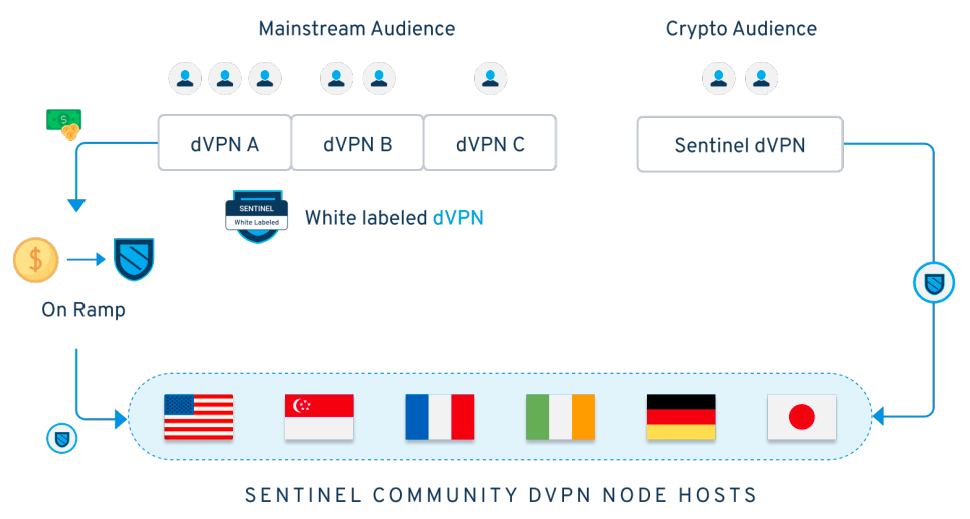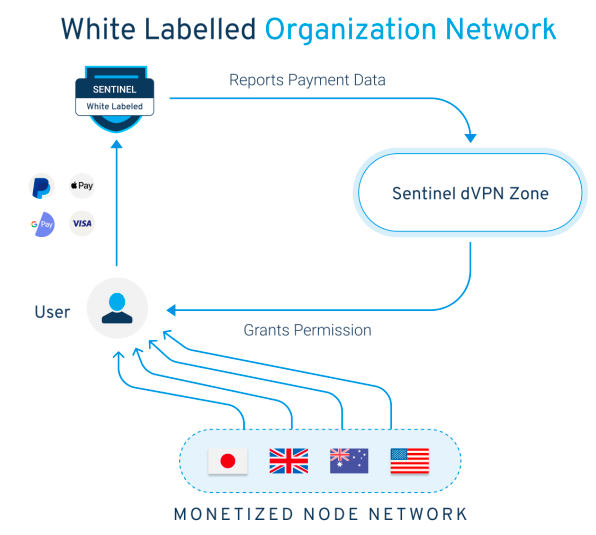Cosmos Ecology-DVPN White Paper (2) Decentralized VPN Industry
Sentinel is not a single dVPN application, but an independent network, and the dVPN application is built on Sentinel's dVPN protocol framework.
The goal of the Sentinel ecosystem is to decentralize the VPN industry and bring "dVPN" to mainstream consumers. However, this goal will not be achieved by publishing and maintaining a single consumer-facing application (Sentinel dVPN), but by first building and developing a framework that can be used to create an independently operating decentralized VPN network.

A dvpn built on the Sentinel framework can be operated by corporate entities or individuals. Sentinel also intends to work with existing centralized VPN providers to help them transition their backend architecture to a decentralized one; allowing these companies to further build trust with their existing customer base while also allowing them to further expand their service offerings .
You might find yourself wondering why an entrepreneur or existing organization would want to partner with sentinel to build a dVPN?
Sentinel's ecosystem eases three barriers to entry for new and existing VPN companies
- Cost and process of dVPN application development: Network protocols such as OpenVPN and Wireguard, although fully open source, need to be packaged into a scalable, secure set of "cross-platform" applications. Meanwhile, integrating subscription-based systems and payment gateways provides a tedious example of some of the more basic implementations needed to develop a dVPN network. The resource requirements needed to develop a high-end VPN/dVPN application from scratch are detailed for most people.
- Sentinel provides an open source, cross-platform dVPN client that is resilient, secure and highly scalable. This is because Sentinel adopts a cosmos-based architecture that provides a public-private key "account management" system in addition to on-chain node queries (more details to be announced in future publications). We make sure that building and customizing the architecture on top of Sentinel's framework is developer-friendly. The cost of the whole process is very competitive compared to developing your own VPN/dVPN app
- Node management and DMCA request handling: Leading cloud service providers will inevitably limit server access to exit node hosts, as streaming or downloading pirated content from that node will undoubtedly attract DMCA requests. Centralized VPN organizations often have to rely on "offshore hosting services" that may not offer the same level of reliability as more established providers in terms of uptime and live customer support.
- By integrating Sentinel's community-based node host, the Sentinel ecosystem removes exit-node management responsibilities for organizations building applications on the Sentinel framework.
- Owners of VPN applications will have the ability to create service contracts and establish certain quality standards with node hosts in the Sentinel ecosystem, without having to manage the ownership of those servers themselves
- Potential security threats and hacking-related risks: Code closed-source and centralized VPN solutions cannot be peer-reviewed and therefore cannot be evaluated by impartial security experts. This could lead to a potential vulnerability or security risk, with the ability to damage or severely damage the reputation of the company providing the service.
- The occurrence of security breaches not only puts users at risk that their data may be exploited, but also leads to a severe lack of trustworthiness in the VPN organization itself, which can significantly impact the organization's revenue and sustainability.
- This open source structure provided by Sentinel greatly reduces the chance of security breaches. An example of the advantages of open source software is that military organizations around the world use Linux as their operating system of choice for most of their systems. Linux is completely open source and is often scrutinized by third parties; unlike software suites like Windows, it is closed source and has a reputation for security issues.
While the Sentinel framework provides the tools and infrastructure to build and operate a robust dVPN service, it is the responsibility of the application owner to acquire customers and understand their specific target market in order to deploy an effective marketing strategy. It is important to note that product development and execution are only part of the many important factors. The other part revolves around the actual hands of the user and building a product that the market needs.
4 key principles for successful dVPN application
- Robust UI/UX: Apps built on the Sentinel framework should be indistinguishable from leading industry-provided VPN services in terms of user-friendliness and ease of access. Users may be reluctant to transition to a more decentralized solution unless their onboarding process is seamless, even amid the growing trend of demand for secure and transparent VPN services. The learning curve of using a dVPN app must be minimized by using smart design. To embody a strong brand image, there must be a strong focus on the specific aesthetic of the app.
- Effective Pricing Strategy: When trying to build a successful dVPN application, the implementation of a pricing model that is not only cost-effective but also profitable plays a crucial role. It is important for the application to be able to generate revenue which is then passed on to the node host. This enables them to monetize the bandwidth resources provided, creating a healthy and sustainable decentralized economy. The pricing model employed is entirely dependent on the target demographic and the type of service offered by the app. In the future, creators of dVPN apps in the Sentinel ecosystem will be able to offer premium services within their apps. These advanced services include a blockchain framework for building decentralized VPN applications, an upcoming relay network, and other enhanced privacy-related implementations. Additional services can be priced within a user's existing subscription or can be monetized based on the amount of data actually used. Regardless of the pricing strategy or revenue model employed by the dVPN owner/operator, it is the responsibility of the developer of the app to conduct proper due diligence and analysis to arrive at the best pricing model.
- Mainstream payment gateway integrations: Critically, Sentinel framework-based applications allow users to make purchases through fiat-based payment options, such as: Visa/Mastercard, Apple Pay, Google Pay, e-wallets (paypal, skrill, etc.). Only cryptocurrency-related payment options create a huge barrier to entry, preventing the average consumer from easily transitioning from a centralized VPN service provider elsewhere. While nodes hosted within the Sentinel ecosystem must be paid through the use of digital blockchain-based assets, dVPN application owners have the ability to monetize their applications through the use of fiat payment channels. The collected fiat currency can be converted into digital assets using an "inbound" service, which is then used to pay node hosts.

- Diversity of routing protocols: Different regions require specific routing protocols to seamlessly access data from the Internet while avoiding potential obstacles. In order to properly deploy optimal "user-specific" routing protocols in dVPN applications, the complexities and characteristics of various geographic locations must be fully understood. Network configuration performed seamlessly in one geographic location may be completely redundant in another, thus requiring a customized approach when selecting the appropriate routing protocol for a dVPN application. For example, the OpenVPN protocol cannot bypass the firewalls of several different countries, while it functions in other countries without any obstacles.
Like my work? Don't forget to support and clap, let me know that you are with me on the road of creation. Keep this enthusiasm together!

- Author
- More